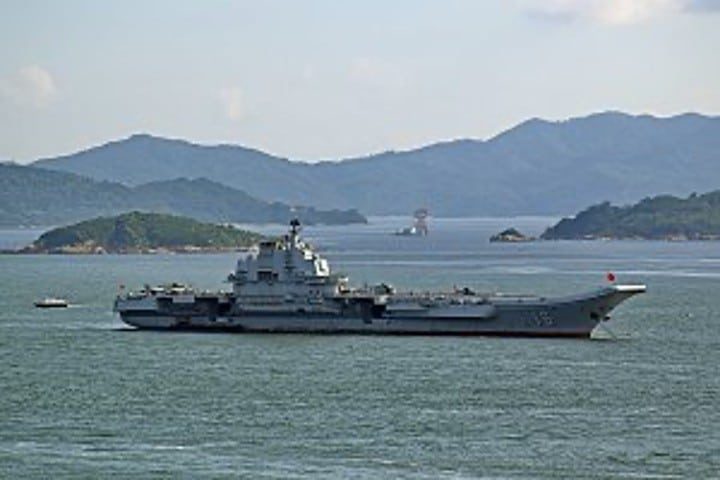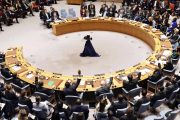
SINGAPORE — A Chinese carrier strike group has been staging drills simulating attacks on Japan’s Nansei Islands since December 16, Yomiuri Shimbun quoted Chinese government sources as saying.
The sources said that Chinese President Xi Jinping gave orders to the military to begin the drills on the day the Japanese government issued three major defense-linked documents. Additionally, strategic bombers will simulate a pincers attack targeting Taiwan from the east and west during the exercises.
Based on the sources, a unit in the western Pacific south of Okinawa Prefecture directed by the Chinese navy’s aircraft carrier Liaoning is involved in the drills, which also entailed advanced vessels capable of ground attacks.
China will supposedly stage long-range strike drills from waters in the western Pacific, simulating missile launches on islands in the Nansei chain, on which Japan is mulling over dispatching missiles. Ship-borne aircraft have begun night landing and takeoff exercises, and around 130 takeoffs and landings have supposedly occurred.
Although the Chinese military’s carrier strike group typically conducts yearly winter drills around December, Xi stipulated a start date this year and the goal of derailing Japan’s security strategy against China, Chinese government sources said.
The Japanese Defense Ministry confirmed that the Liaoning and other vessels in the carrier strike group passed between Okinawa and Miyako islands, entering the Pacific Ocean on December 16. These vessels sailed 260 kilometers west-southwest of Okidaito Island the next day. They were later noticed 450 kilometers east-northeast of Kitadaito Island, from which ship-borne aircraft can arrive at the Nansei chain in 5 to 10 minutes.
The U.S. Defense Department said that the Chinese military has been implementing a strategy of active defense that could result in a preemptive strike on an enemy if Beijing perceives that it is about to be threatened.
Japan’s security documents have indicated the country’s plans to acquire counterattack capabilities in response to China. Not surprisingly, the Xi regime in Beijing is on its guard regarding a huge deployment of Japanese missiles on the Nansei Islands.
Based on an announcement from the Chinese Defense Ministry, the Chinese navy also recently started joint drills with the Russian navy off Zhoushan, Zhejiang Province. The ministry admitted that the exercises will encompass anti-submarine and maritime blockade drills.
Earlier this year, Japanese Prime Minister Fumio Kishida called on other Group of Seven (G7) leaders in Germany to guarantee that countries did not learn the “wrong lessons” from the Russia-Ukraine crisis, such as the present situation in East Asia in which China is amping up its military pressure on Taiwan.
Furthermore, the Japanese premier highlighted that he would not permit Beijing’s construction of gas fields in the East China Sea, alluding to construction work that is underway as “a unilateral attempt to change the status quo by coercion.”
Kishida also broached China-related issues during diplomatic and security talks at the summit. “We must strengthen the international order and reject the world becoming a place where unilateral changes to the status quo by force can occur without question, such as the invasion of Ukraine,” he said, noting that such changes were persisting and escalating in the Indo-Pacific.
Beijing is currently setting up infrastructure in the East China Sea without an agreement from Japan. Also, Chinese vessels have made repeated incursions into territorial waters around the Senkaku Islands in Okinawa Prefecture. “The situation in the East China Sea and the South China Sea is extremely serious,” Kishida said.
He also expressed grave worries over North Korea, which remains intransigent in developing nuclear weapons and missiles. “While the international community is focused on dealing with the aggression in Ukraine, we mustn’t mislead the [North Korean] regime into thinking that a window has opened for missile development.”
During a keynote speech at the three-day Shangri-La Dialogue security summit in Singapore this year — the first keynote address by a Japanese prime minister in eight years — Kishida pointed out the importance of boosting a rule-based international order and spoke of his plans to develop by next spring an action plan to foster a Japan-led “free and open Indo-Pacific.”
He also laid out blueprints to offer in the next three years at least $2 billion in aid to Indo-Pacific countries — including those of the Association of Southeast Asian Nations — for maritime security equipment including patrol vessels and the development of maritime transportation infrastructure.
With China in mind, he broached ongoing attempts to alter the status quo in the South China Sea and East China Sea by military means, saying, “Confidence in the universal rules that govern international relations is being shaken.”
The prime minister also announced the “Kishida Vision for Peace” and the role that Japan should play in it. The five-pillar vision calls for: maintaining and enhancing the rule-based international order; boosting Japan’s defense capabilities together with entrenching the Japan-U.S. alliance and boosting security cooperation with other like-minded countries; fostering realistic efforts to enable a world without nuclear weapons; boosting the functions of the United Nations; and increasing international cooperation in new policy areas such as economic security.
During the Singapore summit, Kishida also expressed his plans to fundamentally overhaul Japan’s defense capabilities within the next five years and secure a “substantial increase” in the nation’s defense budget.
On the topic of denuclearization, he said, “Mindful of the non-transparent manner in which some countries have been increasing their nuclear capabilities, we call for all nuclear-weapon states to disclose information regarding their nuclear forces,” and added his desire for the United States and China to participate in bilateral discussions on nuclear disarmament and arms control.



